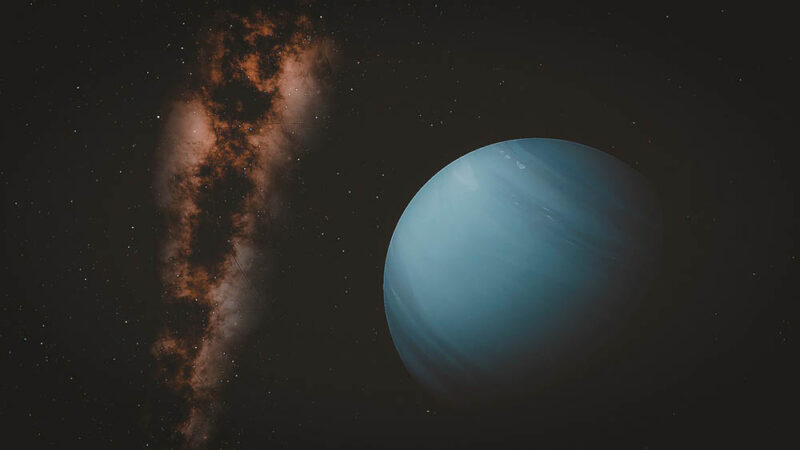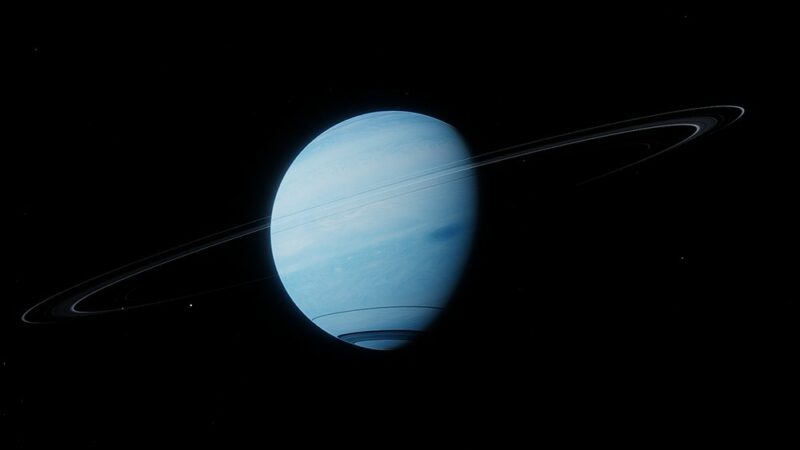Does It Rain Diamonds on Neptune? Is There Finally Enough Evidence?
Last Updated on

Neptune is the farthest planet from Earth. That accounts for how relatively little we know about it. What we do understand is that it’s nothing like our world. Whereas the Earth is conducive to life, Neptune is not. Its atmosphere doesn’t contain nitrogen and oxygen in the quantities we need to survive. Plus, it’s nearly 30 times farther from the Sun.
Our knowledge of this planet comes from the few space missions that have yielded valuable data. One strange thing you might have heard about Neptune is that it rains diamonds. But is that just a myth? Without definitive physical information, we can only speculate. Scientists have hypothesized that it could occur theoretically.

Diamond Formation
It’s helpful to begin our discussion by talking about diamonds. Diamonds are a naturally occurring allotrope of pure carbon. They exist in a crystal formation that gives it its characteristic sparkle, facets, and resulting hardness. People often find them in a special type of igneous rock called kimberlites. This information provides the first clues about how diamonds could form on Neptune.
Igneous rock is formed by the cooling of molten magma. The magma comes from melting chunks of the Earth’s crust or mantle. These are the outer two layers of the four layers of the Earth—the inner two being the outer and inner core. The crust is about 19 miles thick, whereas the mantle extends around 1,800 miles. While the crust is solid, the next layer exists in a thick, semi-fluid form.
Scientists have never explored the mantle and likely never will because the temperatures range from 1,832℉–6,692℉. Diamonds forming from this material require high temperatures and pressure. Such conditions may exist on Neptune. Evidence suggests that a layer of super-hot liquid is trapped under enormous pressure on Neptune, setting up the ideal conditions for diamond formation.
We know that diamonds are old rocks, with some dating back a billion or more years. However, the Earth and its mantle were likely hotter than they are now, adding further credence to the Neptune-diamond theory. However, diamonds probably traveled to the Earth’s surface through volcanic eruptions instead of raining, as some have posited.
The Raw Materials
The primary material for diamond formation is carbon. Therefore, our ingredient list for diamonds includes high temperatures, pressure, and carbon.
Scientists theorize that the inner layer of Neptune contains ammonia, carbon, methane, and water, while
the atmosphere consists of hydrogen, helium, and methane. It appears that the necessary raw materials are present for this theory.
This led scientist Marvin Ross to take it one step further to hypothesize that subjecting these organic chemicals to high temperatures and pressure could create conditions where diamonds could form.

The Planet in the Lab
It’s possible to create synthetic diamonds in a lab by replicating similar high-pressure conditions that occur in the Earth’s mantle. Neptune has a similar pattern of layer formation. While it’s not solid, its ice layer is incredibly thick at an estimated 10,874 miles. Bear in mind that Neptune is nearly four times larger than the Earth. The result is even higher pressure than our planet endures.
These conditions could create the so-called perfect storm for diamond formation based on computer modeling. If the forces came together to forge this mineral, its strong bonds could create crystal sheets. Diamond formation is possible in space from evidence scientists have gathered from meteorites. Thus, it’s not totally impossible that there are lots of diamonds on Neptune.

Conclusion
Only two NASA missions have traveled close enough to Neptune to provide any concrete evidence of what secrets it may hold. Its conditions provide compelling evidence that diamonds can form on this planet. Whether they actually rain from the sky or not, though, is another story.
Knowing that diamonds exist on meteorites tells us that the formation of this mineral may be more common than we expect. It may also explain the unique qualities of this ice giant and provide further clues about the creation of the Universe.
Featured Image Credit: CharlVera, Pixabay
Table of Contents
About the Author Chris Dinesen Rogers
Chris has been writing since 2009 on a variety of topics. Her motto with all of her writing is “science-based writing nurtured by education and critical thinking.” Chris specializes in science topics and has a special love for health and environmental topics, and animals of all shapes and sizes.
Related Articles:
How to Clean a Refractor Telescope: Step-by-Step Guide
How to Clean a Telescope Eyepiece: Step-by-Step Guide
How to Clean a Rifle Scope: 8 Expert Tips
Monocular vs Telescope: Differences Explained (With Pictures)
What Is a Monocular Used For? 8 Common Functions
How to Clean a Telescope Mirror: 8 Expert Tips
Brightfield vs Phase Contrast Microscopy: The Differences Explained
SkyCamHD Drone Review: Pros, Cons, FAQ, & Verdict
